Dumbbell vs Barbell Bench Press: Differences, Pros, Cons | PowerliftingTechnique.com (original) (raw)
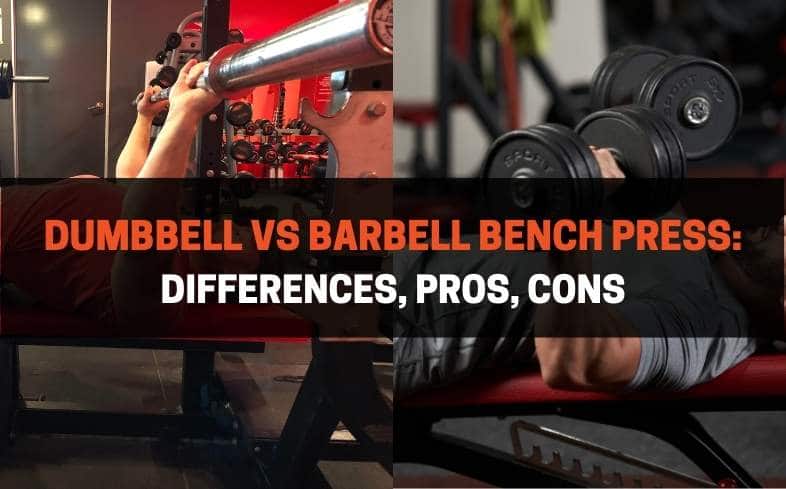
The bench press is one of the most popular exercises whether you are trying to increase muscle mass on your pecs or increase upper body strength. The dumbbell bench press is a common alternative or addition to the barbell bench press in people’s workouts.
But what are the differences between the dumbbell bench press vs the barbell bench press? The dumbbell bench press loads each side of your body with two independent loads, has a stronger demand for stability, and potentially more range of motion. The barbell bench press allows you to be able to move more overall weight through your chest and triceps.
In this article, I will go through exactly what the differences are between the dumbbell press vs bench press, how to best perform them, and key points regarding what the pros and cons are. By the end, you’ll be able to determine which exercise will be more beneficial to add to your training routine.
Table of Contents
Toggle
- Differences Between a Dumbbell and Barbell Bench Press
- Dumbbell Bench Press: How To, Tips, Common Mistakes, Muscles Used, Pros and Cons
- Barbell Bench Press: How To, Tips, Common Mistakes, Muscles Used, Pros And Cons
- Frequently Asked Questions
- Other Upper Body Exercise Comparisons
- Final Thoughts
- About The Author: Norman Cheung ASCC, British Powerlifting Team Coach
Differences Between a Dumbbell and Barbell Bench Press
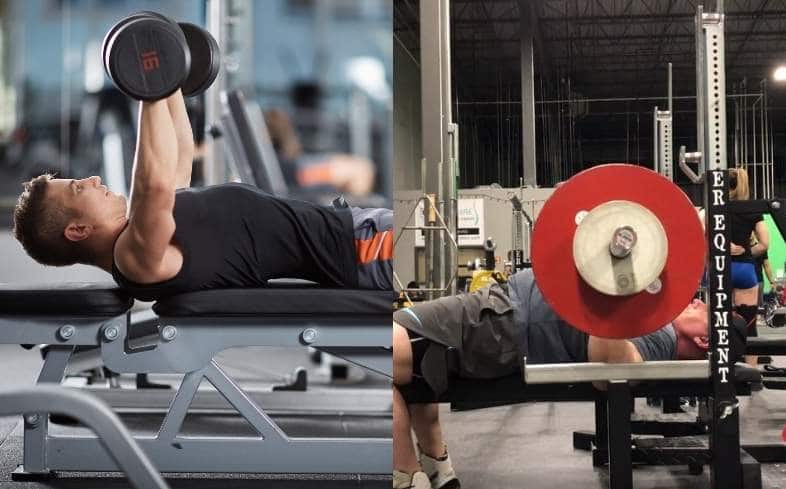
There are 4 main differences between the dumbbell bench press vs. the barbell bench press:
- Equipment you need to use
- How to perform the exercises
- Emphasis on the muscle groups
- Exercise range of motion
1. Equipment You Need to Use
Both the dumbbell bench press and barbell bench press use a flat free weight bench. However, a barbell bench press may require you to either be in a power cage or use a bench with a barbell rack.
The dumbbell bench press relies on using a pair of dumbbells whereas the regular bench press uses a barbell.
2. How to Perform the Exercises
While the overall movement of the dumbbell bench press and barbell bench press is similar, how the arms move differs slightly. Both require you to keep your shoulder blades pinched back while the load is pressed up and down.
With the dumbbell bench press, there is more of an arch with the bar path. As the dumbbells are lowered, the forearms are brought outwards and away from each other. As the dumbbells are pressed upwards, the forearms are brought closer in towards each other.
With the barbell bench press, there is more of a straight-up and downward motion of the forearms, with the hands staying a consistent distance away from each other.
Wondering if it’s better to keep your hands wide in the bench press? Check out Wide Grip Bench Press: Is It Better?
3. Emphasis on the Muscle Groups
The dumbbell bench press and barbell bench press both target the pecs (the muscles in the chest), deltoids (the shoulder muscles), and tricep muscles.
However, research has shown that the dumbbell bench press targets the pectoralis major muscle (the largest muscle in the chest) significantly more than the barbell bench press. Additionally, according to that same study, the barbell bench press activates the triceps more than the dumbbell bench press.
Wondering if the bench press is enough to train the chest? Check out Is Bench Press Good Enough For Chest? (Expert Opinion).
4. Exercise Range of Motion
The range of motion in the dumbbell bench press can be more than the barbell bench press, although this will vary from person to person regarding how much.
The dumbbell bench press has a higher range of motion because when you lower the weight, you do not have a barbell to impede the descent of your arms. This means you can stretch your pec muscles more. Also, when you press the dumbbells upwards, you also bring your arms closer together, which increases how much your pec muscles contract.
Even though the dumbbell bench press won’t make a significant difference in much weight you can use for your barbell bench press, it’s still a beneficial exercise to include in your routine. Learn more in Does Dumbbell Bench Press Help Your Barbell Bench Press?
Dumbbell Bench Press: How To, Tips, Common Mistakes, Muscles Used, Pros and Cons
How to do a Dumbbell Bench Press (6 Steps)
Step 1: Sit down at the end of a flat bench and rest the flat sides of a pair of dumbbells on your knees
Sit at the edge of a free-weight bench while holding onto a pair of dumbbells by your knees.
Step 2: Kick the dumbbells up to your shoulders and lie down on the bench
As you lie down onto the bench, kick the dumbbells back towards yourself. Hold them above your shoulders with your arms extended and shoulder blades pinched back.
Step 3: Hold the dumbbells with your palms facing forward while keeping your shoulders down and back
Make sure your palms are facing your lower body and that your shoulders are evenly depressed.
Step 4: Bring the dumbbells down as low as you can without letting your shoulders rise from the bench
Inhale as you lower the dumbbells towards lower chest level as low as you can without popping your shoulders off the bench.
Step 5: Push the dumbbells up and towards each other
Exhale as you press the dumbbells upwards and toward each other
Step 6: Repeat for the desired number of reps and safely bring the dumbbells back down without dropping them
Repeat for the desired number of repetitions. When you are done, bring your knees toward the dumbbells and rock forward until you get up and off the bench. Alternatively, you can bring your dumbbells down to your chest and put the dumbbells onto the floor.
Looking to add dumbbells to your home gym that can be dropped? Check out these 7 dumbbells that you can drop without damaging them.
Tips for Performing the Dumbbell Bench Press
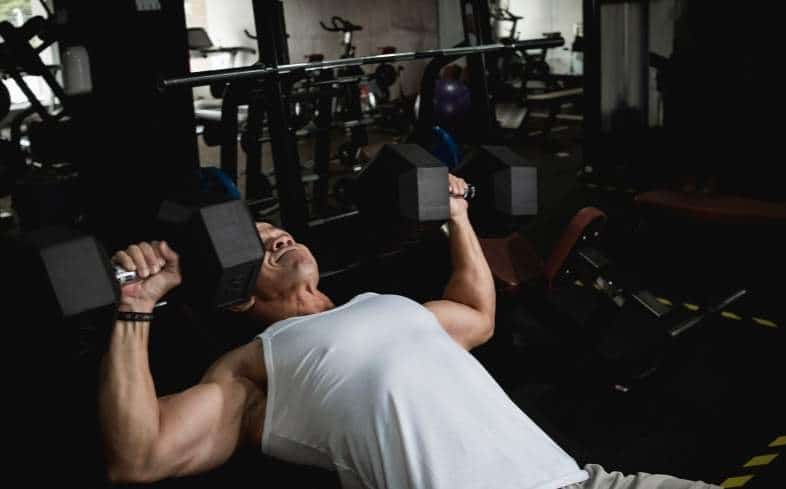
Here are 3 top tips for performing the dumbbell bench press:
- Avoid going to failure if you have asymmetries. If you know one side is stronger than the other or you know you move your right or left arm slightly differently than the other, training to failure or at least close to it will fatigue one arm before the other. This will mean that your technique will break down as the weaker arm struggles. Training with technique breaking down could reinforce these asymmetries. This could exacerbate the stress going through the weaker shoulder and potentially injure you.
- Rotate the forearms as you press up. If you reach a level of strength where the dumbbells are large in terms of weight and dimensions, the ends of the dumbbells can restrict the range of motion at the top. Rotate your arms so that your palms face each other and you can bring the dumbbells closer together to give your pecs a close contraction.
- Tuck the elbows to move stress away from the shoulder joints or pecs. If you want to move the stress away from the shoulder joint or pecs, you can tuck your elbows closer to your torso during the descent. This will move the focus more on the triceps and front deltoid muscle as opposed to the pecs. This would be useful for anyone who has had shoulder issues from bench pressing movements.
One way to further address muscle imbalances is to do the single-arm dumbbell bench press. I discuss how to do it and the pros and cons of the exercise in Single-Arm Dumbbell Bench Press: How To, Pros, Cons.
Common Mistakes With Dumbbell Bench Press
The most common mistakes I see with the dumbbell bench press are:
- Flaring the elbows out too much. You want to flare the elbows so you can maximize how much you stretch the pecs out, but you do not want to flare too much as you can injure your shoulder joint. The dumbbells should be level with your lower chest level.
- Cheating the range of motion. It is hard to visually tell how low you are going when you bring the dumbbells down. You will need to feel the position of your arms to tell where your bottom end range of motion is. This makes it easy to cheat the range of motion by not going as low as you progress through the set.
- Not keeping your shoulder blades back. Keeping the shoulder blades back will be an important part of keeping your shoulders healthy during the dumbbell bench press. It will naturally be difficult to move your shoulder blades when they are held down on the bench while holding onto dumbbells. To minimize stress going through the stabilizer muscles around your shoulder, you need to keep them pinched back.
Muscles Used During Dumbbell Bench Press
The muscles that are used during the dumbbell bench press are:
- Pectoralis Major – These are the main chest muscles that you can visually see. They help bring your upper arm towards the middle of your body.
- Deltoids – These are the main shoulder muscles. The front and side deltoids are the ones that are most active in the dumbbell bench press.
- Triceps brachii – These are the muscles at the back of your arms that extend your elbows when you press.
All bench press variations will activate all of these muscle groups, but due to the extra movement range you get in the dumbbell bench press, the pectoralis major is activated more in this variation.
Benefits of a Dumbbell Bench Press
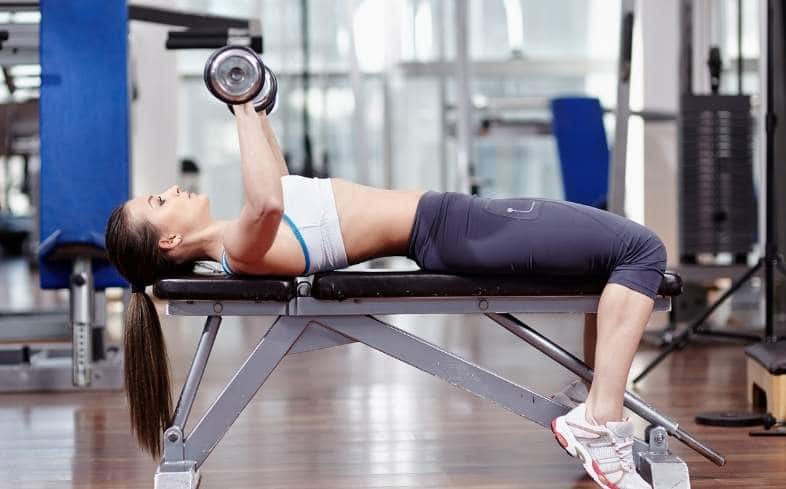
Three of the biggest benefits of the dumbbell bench press are:
- Independent loading on each arm. Each of your arms holds onto an individual weight that is not connected to the other side. Therefore, each arm will need to contribute the same amount of effort when performing the exercise. This is great for people who tend to have one arm stronger than the other.
- More range of motion through the pecs. If your goals are to focus more on growing your chest muscles, you may want to choose a dumbbell bench press over the barbell bench press.
- Instability of the exercise elicits the need to control the descent. Due to the nature of the exercise, there is a greater sense of instability when holding onto the weights. This instability encourages you to pay attention to controlling the weights more and slowing the movement down. This slowing of the repetition movement increases time under tension in the muscles, which is beneficial for stimulating muscle gain.
If you’re looking for more ways to target the chest muscles, check out Dumbbell Chest Workout Without A Bench.
Cons of a Dumbbell Bench Press
Three cons of the dumbbell bench press are:
- Asymmetries can come through. If you naturally have bad asymmetries in terms of strength on each side, they are prone to come through if you push the difficulty on the exercise. This means that someone in your position should not go for heavy loads and low reps or push close to failure in each set.
- Difficult to set up when attempting heavy weights. If your goal is to increase strength, you generally want to be exposed to heavy weights. The dumbbell bench press is not the best choice if you want to go heavy relative to your strength levels. It can be difficult and somewhat risky when trying to set up this exercise by getting the dumbbells into the starting position, and the risk of failing or dropping the weights is higher.
- You cannot standardize the range of motion across reps. As it is common to cheat the range of motion in this exercise, you cannot standardize the quality of the repetitions across the reps. This makes it difficult to reliably monitor whether your performance has really improved or you are just lifting heavier but moving through a shorter range of motion.
Barbell Bench Press: How To, Tips, Common Mistakes, Muscles Used, Pros And Cons
How to do a Barbell Bench Press (6 Steps)
Step 1: Adjust a power cage or bench press station to a level where you can easily unrack the bar and load your desired weight
Set the barbell to be at a level at which you can unrack it easily and load it with your desired weight.
Step 2: Lie on the bench and position yourself so your eyes are underneath the barbell
Lie down onto the bench with your eyes underneath the barbell, and keep your shoulder blades pinched backward and downward.
Step 3: Grip the barbell with your hands placed an even distance apart from each other and unrack it
Grab onto the barbell with your hands spaced evenly apart, unrack it, and hold it above your shoulders.
Step 4: Inhale and bring the barbell down towards your chest
Inhale and lower the barbell towards the lower chest level.
Step 5: Exhale and press the barbell back up
Exhale as you press the barbell upwards and towards the original starting point above the shoulders.
Step 6: Complete all reps and re-rack the bar when you’re done
Repeat for the desired number of repetitions. When you are done, rack the barbell into the J hooks.
Tips for Performing the Barbell Bench Press
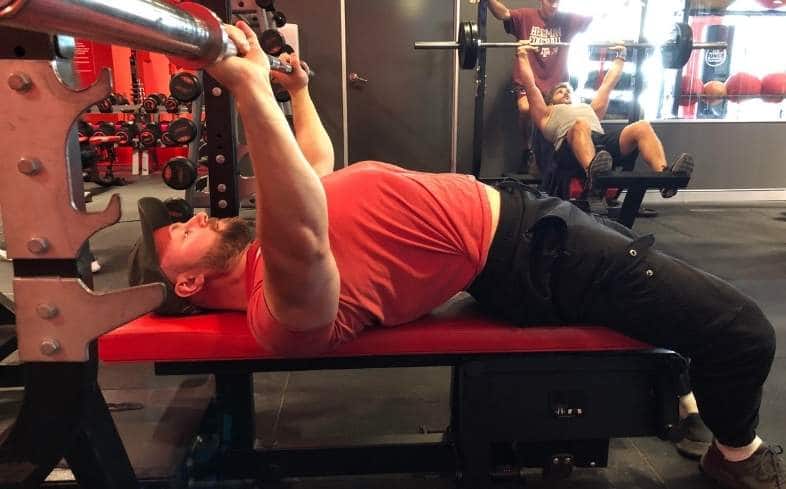
Here are 3 top tips for performing the barbell bench press:
- Use the cue “meet the chest to the barbell” on the descent. This is a really good cue to help maintain a strong and stable retraction of your shoulder blades. Stable shoulder blades will allow you to maximize effort in the pressing motion.
- Use leg drive to keep your shoulder blades pinched down. When you have a barbell that keeps your shoulder blades fixed to the bench, using leg drive to kick yourself back will help keep your ribcage upwards, which will also help keep your shoulder blades pinched back and down.
- Use wrist wraps to keep a stable hold on the barbell. If you struggle with this exercise because your wrists roll a lot, you can try using wrist wraps so you can pay less attention to instability and more attention to pressing harder with your chest and tricep muscles. This will consequently help improve your performance.
Wondering if you should arch your back in the barbell bench press? Check out The Bench Press Arch (How To Do It, Benefits, Is It Safe).
Common Mistakes With Barbell Bench Press
The most common mistakes I see with the barbell bench press are:
- Not going through the full range of motion. The barbell bench press should be an exercise that is easy to standardize the range of motion. This is because the bottom of the range of motion is when the barbell can touch your chest. Not meeting this point is reducing your range of motion, which reduces your stimulus for muscle mass and strength. An ideal barbell touchpoint in the bench press is somewhere between the sternum and lower pecs.
- Allowing the chest to collapse when you bring the barbell down. Allowing the chest to collapse will put your shoulders in a weaker position to be able to press. If your chest collapses, your shoulder blades are likely to roll out of the original position. This can put undue stress on your shoulders and increase the risk of straining or injury.
- Overly tucking the elbows when you perform the exercise. When you overly tuck your elbows, you put less stress on your pecs, but you put more demand on your elbows and triceps, which can make it less efficient.
Muscles Used During Barbell Bench Press
The muscles that are used during the barbell bench press are:
- Pectoralis Major – These are the main chest muscles that you see on the front of the body. They work to bring your upper arm across your body.
- Deltoids – These are the main shoulder muscles. The front and side deltoids are worked the most in the barbell bench press.
- Triceps brachii – These are the muscles of the arms that extend your elbows when you press objects away from you.
All bench press variations will activate all of these muscle groups, but studies have shown that the barbell bench press seems to activate the triceps more than the dumbbell bench press.
Learn more about all of the muscles used in the bench press in Muscles Used In Bench Press (A Complete Guide).
Benefits of a Barbell Bench Press
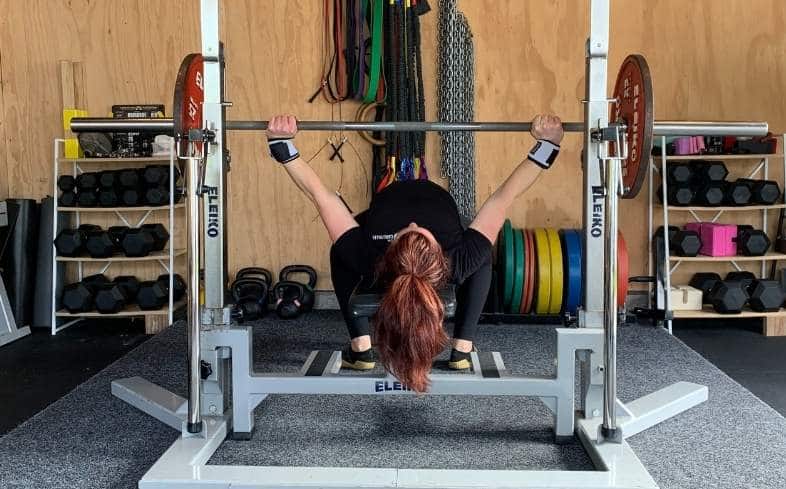
Three key benefits of the barbell bench press are:
- You can perform heavy loads to increase strength. If you want to increase strength, you need to be lifting higher intensity loads. The barbell bench press with an appropriate bench setup is a safe and effective exercise to perform heavy loads with. The J hooks in the bench press station are useful for unracking and reracking the bar before and after execution.
- Standardize performance through constant time under tension. The barbell bench press is a good exercise to monitor improvements in upper body strength as the range of motion is standardized through multiple reps.
- Safe to spot and safe to set up. The barbell bench press is generally safer and easy for spotters to be able to help with the lifter during execution. When the lifter fails, the spotter can just grab the barbell. During the dumbbell bench press, the lifter can fail in several different ways, which can be more dangerous for a spotter.
Cons Of A Barbell Bench Press
Three cons of a barbell bench press are:
- Unsafe to perform heavy loads alone. There have been many stories of tragic injuries occurring when people have failed a barbell bench press. If you train alone at home, it is not advised to perform the bench press unless you have a safety rack that catches the barbell or avoid using barbell collars so you can allow the plates to slide off.
- The stronger arm can take over during execution. The stronger arm can take over if the weight is heavy or if the reps get harder as you progress through a set. This can reinforce asymmetries.
- Less range of motion. The barbell bench press generally does not provide the best range of motion for activating the chest muscles. This is because the barbell restricts how low it can go, and how you hold onto the barbell can also restrict your range at the top. Dumbbell, cable, and machine alternative bench press exercises can be better in terms of the range of motion.
Frequently Asked Questions
It Better to Bench Press with Dumbbells or a Barbell?
It is better to bench press with dumbbells if you want to prioritize the chest muscles, but if you want to activate the triceps more, you can use the barbell. The bench press with a dumbbell provides more range of motion, so if your goal is to build muscle, then choose a dumbbell bench press.
Why Is the Dumbbell Bench Press Harder than the Barbell Bench Press?
The dumbbell bench press is harder than the barbell bench press because it is harder to set up, and the exercise is inherently less stable to perform. As well, the stronger arm cannot compensate for the weaker arm during the dumbbell bench press.
Is the Dumbbell Press Good for the Chest?
Yes, the dumbbell press is good for the chest. It is superior to many other exercises for targeting the chest muscles and it allows you to achieve an excellent range of motion.
Other Upper Body Exercise Comparisons
- Dips vs Decline Bench Press: Pros, Cons, Which Is Better?
- Bench Press vs Overhead Press: Differences, Pros, Cons
- Floor Press vs Bench Press: Differences, Pros, Cons
- Upright Row vs Lateral Raise: Differences, Pros, Cons
- Pendlay Row vs Barbell Row: Differences, Pros, Cons
- T-Bar Row vs Barbell Row: Differences, Pros, Cons
- Dips vs Push Ups: Pros, Cons, Which Is Better?
- Close vs Wide Grip Lat Pulldown: Which Is Better?
Final Thoughts
So, what’s the verdict? Which one is better – the dumbbell bench press or barbell bench press? Truthfully, both exercises are great for training the chest and tricep muscles. The main difference between the two is that the barbell bench press allows you to lift more weight and therefore results in greater strength gains.
If you want to focus on increasing muscle mass and size, go with the dumbbell bench press. You should also go with the dumbbell bench press if you’re looking for a lighter option that still provides a challenging workout.
About The Author: Norman Cheung ASCC, British Powerlifting Team Coach
Norman Cheung is a powerlifting and accredited strength and conditioning coach under the UKSCA. He has been coaching powerlifting since 2012 and has been an IPF Team GB coach since 2016. He has experience coaching various lifters, from novices to international medallists and international university teams. Alongside coaching, he takes an interest in helping powerlifters take their first step into coaching. He currently runs his coaching services at strongambitionscoaching.com.